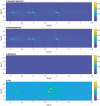Predicting Antidepressant Effects of Ketamine: the Role of the Pregenual Anterior Cingulate Cortex as a Multimodal Neuroimaging Biomarker
- PMID: 35948274
- PMCID: PMC9743970
- DOI: 10.1093/ijnp/pyac049
Predicting Antidepressant Effects of Ketamine: the Role of the Pregenual Anterior Cingulate Cortex as a Multimodal Neuroimaging Biomarker
Abstract
Background: Growing evidence underscores the utility of ketamine as an effective and rapid-acting treatment option for major depressive disorder (MDD). However, clinical outcomes vary between patients. Predicting successful response may enable personalized treatment decisions and increase clinical efficacy.
Methods: We here explored the potential of pregenual anterior cingulate cortex (pgACC) activity to predict antidepressant effects of ketamine in relation to ketamine-induced changes in glutamatergic metabolism. Prior to a single i.v. infusion of ketamine, 24 patients with MDD underwent functional magnetic resonance imaging during an emotional picture-viewing task and magnetic resonance spectroscopy. Changes in depressive symptoms were evaluated using the Beck Depression Inventory measured 24 hours pre- and post-intervention. A subsample of 17 patients underwent a follow-up magnetic resonance spectroscopy scan.
Results: Antidepressant efficacy of ketamine was predicted by pgACC activity during emotional stimulation. In addition, pgACC activity was associated with glutamate increase 24 hours after the ketamine infusion, which was in turn related to better clinical outcome.
Conclusions: Our results add to the growing literature implicating a key role of the pgACC in mediating antidepressant effects and highlighting its potential as a multimodal neuroimaging biomarker of early treatment response to ketamine.
Keywords: antidepressant effects; ketamine; multimodal neuroimaging biomarker; pgACC; pregenual anterior cingulate cortex.
© The Author(s) 2022. Published by Oxford University Press on behalf of CINP.
Figures




Similar articles
-
Anterior cingulate desynchronization and functional connectivity with the amygdala during a working memory task predict rapid antidepressant response to ketamine.Neuropsychopharmacology. 2010 Jun;35(7):1415-22. doi: 10.1038/npp.2010.24. Epub 2010 Mar 10. Neuropsychopharmacology. 2010. PMID: 20393460 Free PMC article.
-
Acute effects of ketamine on the pregenual anterior cingulate: linking spontaneous activation, functional connectivity, and glutamate metabolism.Eur Arch Psychiatry Clin Neurosci. 2022 Jun;272(4):703-714. doi: 10.1007/s00406-021-01377-2. Epub 2022 Jan 12. Eur Arch Psychiatry Clin Neurosci. 2022. PMID: 35020021 Free PMC article.
-
Temporal Dynamics of Antidepressant Ketamine Effects on Glutamine Cycling Follow Regional Fingerprints of AMPA and NMDA Receptor Densities.Neuropsychopharmacology. 2017 May;42(6):1201-1209. doi: 10.1038/npp.2016.184. Epub 2016 Sep 8. Neuropsychopharmacology. 2017. PMID: 27604568 Free PMC article. Clinical Trial.
-
Effect of ketamine on task-based functional magnetic resonance imaging findings in major depressive disorder: A mini-review.J Affect Disord. 2025 Feb 1;370:181-189. doi: 10.1016/j.jad.2024.10.118. Epub 2024 Nov 2. J Affect Disord. 2025. PMID: 39489183 Review.
-
The anterior cingulate cortex as a key locus of ketamine's antidepressant action.Neurosci Biobehav Rev. 2021 Aug;127:531-554. doi: 10.1016/j.neubiorev.2021.05.003. Epub 2021 May 11. Neurosci Biobehav Rev. 2021. PMID: 33984391 Review.
Cited by
-
Ketamine and Zinc: Treatment of Anorexia Nervosa Via Dual NMDA Receptor Modulation.CNS Drugs. 2023 Feb;37(2):159-180. doi: 10.1007/s40263-022-00984-4. Epub 2023 Jan 22. CNS Drugs. 2023. PMID: 36681939 Free PMC article. Review.
-
Recommendations for selection and adaptation of rating scales for clinical studies of rapid-acting antidepressants.Front Psychiatry. 2023 Jun 2;14:1135828. doi: 10.3389/fpsyt.2023.1135828. eCollection 2023. Front Psychiatry. 2023. PMID: 37333908 Free PMC article. Review.
-
Association of the delayed changes in glutamate levels and functional connectivity with the immediate network effects of S-ketamine.Transl Psychiatry. 2023 Feb 16;13(1):60. doi: 10.1038/s41398-023-02346-0. Transl Psychiatry. 2023. PMID: 36797238 Free PMC article.
-
Negative emotionality shapes the modulatory effects of ketamine and lamotrigine in subregions of the anterior cingulate cortex.Transl Psychiatry. 2024 Jun 18;14(1):258. doi: 10.1038/s41398-024-02977-x. Transl Psychiatry. 2024. PMID: 38890270 Free PMC article. Clinical Trial.
-
Safety and efficacy of individual target transcranial magnetic stimulation to stimulate the most negative correlate of DLPFC-pgACC in the treatment of major depressive disorder: study protocol of a double-blind, randomised controlled trial.BMJ Open. 2024 Nov 7;14(11):e081520. doi: 10.1136/bmjopen-2023-081520. BMJ Open. 2024. PMID: 39515856 Free PMC article.
References
-
- Abdallah CG, Hannestad J, Mason GF, Holmes SE, DellaGioia N, Sanacora G, Jiang L, Matuskey D, Satodiya R, Gasparini F, Lin X, Javitch J, Planeta B, Nabulsi N, Carson RE, Esterlis I (2017b) Metabotropic glutamate receptor 5 and glutamate involvement in major depressive disorder: a multimodal imaging study. Biol Psychiatry Cogn Neurosci Neuroimaging 2:449–456. - PMC - PubMed
-
- Alexander L, Jelen LA, Mehta MA, Young AH (2021) The anterior cingulate cortex as a key locus of ketamine’s antidepressant action. Neurosci Biobehav Rev 127:531–554. - PubMed
Publication types
MeSH terms
Substances
LinkOut - more resources
Full Text Sources

